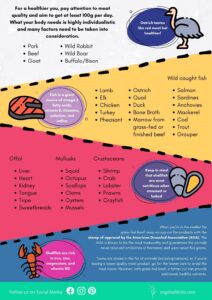"You are what you eat" applies to animals too.
By providing high-quality protein and essential micronutrients such as iron, zinc, and vitamin B12, meat is important in human nutrition. Grass-fed meat is one of the most nutrient-dense proteins you can buy.
Herbivores are meant to eat grass, preferably within open pastures. As the demand for meat has grown over the past century, farmers started feeding their herds grain-based products, usually made from corn and soy (2 of the most genetically modified crops (“GMOs”).
Many scientific studies have been conducted comparing the crucial difference of fatty acids in grass-fed to grain-fed beef. Grass-fed contains much less monounsaturated fat, up to five times more omega-3, and three to four times more CLA* compared to grain-fed beef.
Sixty percent of the fatty acids found in grass are the omega-3 fatty acid Alpha-Linolenic Acid (ALA), which is formed in green leaves. When cattle are taken off grass and fed a grain-rich diet, they lose their valuable store of ALA and other useful fatty acids.
*Conjugated linoleic acid (CLA), another type of fatty acid, is 300%-400% higher in grass fed cuts.
CLA is a nutrient associated with lowering heart disease and cancer risk, as well as reducing body fat and maintaining lean body mass.
Research spanning three decades suggests that grass-only diets can significantly alter the fatty acid composition and improve the overall antioxidant content of beef.
Several studies suggest that grass-fed, pastured animals elevate precursors for Vitamin A and E, as well as cancer fighting antioxidants such as glutathione (GT) and superoxide dismutase (SOD) activity as compared to grain-fed contemporaries.
Meat from fully grass-fed animals also contains considerably more antioxidants, vitamins and minerals, such as beta-carotene and vitamin E, than meat from grain-fed animals.
Just like meat that comes from properly raised animals that have access to pasture and sunshine, seafood caught in the wild, using sustainable practices with an awareness for the environment should be a huge priority.
From a nutritional standpoint, wild caught fish offers more benefits, like higher levels of beneficial omega-3 essential fatty acids. Of course, the taste and freshness of wild caught isn’t even comparable. Wild caught fish is in a league of its own.
The ratio of omega-3 to omega-6 fat of wild salmon, is far superior to farmed.
Farmed salmon has a 1-1 ratio of omega-3s and omega-6s (due to the “junk food diet” they are fed), while the ratio for wild salmon is generally between 6 and 9 to 1, which is a much more ideal and healthful ratio.
Wild salmon swim around in the wild, eating what nature intended and living the way nature intended. Therefore, their nutritional profile is more complete, with micronutrients, fats, minerals, vitamins, and antioxidants like astaxanthin (which is what gives salmon its pink or red colored, flesh.) Most people are severely deficient in omega-3 fats, resulting in a poor omega-3 to omega-6 ratio. Wild caught fish represent a wise and tasty choice for improving this ratio.
In conclusion, sustainably-sourced, wild caught fish is a tasty nutrient-dense, heart healthy, brain-boosting whole food, that makes a great addition to a real food diet. Wild caught fish are a rich source of omega-3 fatty acids, vitamins A and D, B-complex vitamins, selenium, zinc, potassium, and iron.
Farmed fish tend to be very high in contaminants. Arguably the most dangerous pollutant found in salmon is the PCBs, which are strongly associated with cancer and various other health problems.
A downloadable version of this blog complete with tips and meat list is available for you! Just click on the button below to download.





